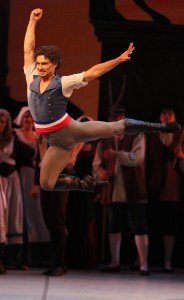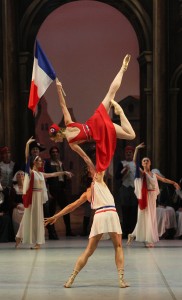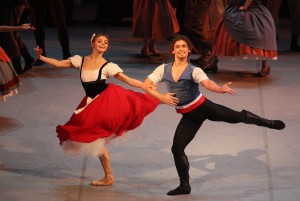By the third performance of the West Coast debut of Mikhail Messerer’s 2013 revival of “The Flames of Paris” (1932), the engine of the recently revamped Mikhailovsky Ballet and Orchestra was running incredibly hot. Never before has a three-act ballet burned by so fast, alternating multilayered scenes of street rebellion and palace treachery effortlessly, peopled by bounding soloists and ensemble dancers making quick work of deluxe turn sequences, devilish footwork and stage-bursting ensemble choreography. What a great coup for the Segerstrom Center, which was the only West Coast venue to see the trip on this first U.S. tour.

Vasiliev has both extraordinary elevation and dazzling landings. His plies are fathoms deep. Photo: Stas Levshin
Vladimir Dmitriev’s stunning sets and costume designs – painting both the peasant and courtiers in glorious detail – handled half the necessary acting here. Director Messerer’s astute amplification of classical epaulement and arm position – the way choreographer Vasily Vaynonen artfully signaled character and class in this romping French Revolution ballet – carried much of the rest of it.
Keeping up with the runaway charge led by Ivan Vasiliev as the revolutionary hero Phillippe was the troupe’s essential challenge. Vasiliev, ballet’s reigning superstar, had a field day with the extraordinary physical feats here – strings of turning jumps with an extra leg crossing over at the last minute, revolutions of changing pirouettes, soaring full-body horizontal leaps plunging down to one knee – and cheers of “Opa!” rang through the house all night.
The way Vasiliev can summon and consume energy is unparalleled – when one string of turns went (incongrously) a little off, you could see him determinedly reset his trajectory while he was spinning, ending even more highly lifted and balanced than in any previous sequence . His commitment and attack burned down to his very eyes, which he flashed dramatically to seal each phenomenal phrase.
His partner, the elegant and creamy Oksana Bondareva, played Jeanne, the peasant’s daughter who goes missing for the central core of the story but firmly launches and caps the drama at either end. Her first gesture was to throw her arms as high as the threatening Marquis; her final spell-binding technical feat – a series of turns where she holds her leg at perfect level in second position for multiple rounds – matched Vasiliev with a quiet glory.
Two other female leads combined with Jeanne to deliver the evening’s satisfying evocation of the revolutionary symbol of Marianne: Ekaterina Borchenko as the clean, posing Diana Mireille and Kristina Makhviladze as Teresa, the Basque woman who storms the stage like a bolting, unbroken horse. As the evil Marquis de Beauregard, Mikhail Venshchikov was a riveting foe for Vasiliev.
In this streamlined drama, where events did not echo, there was a somewhat dull, flat feeling to the story, mirrored in the hypnotic animations of a single giant flag used during set changes. Boris Asafiev’s pastiched music is an inherently weak ballet score in any case, so episodic moments felt like the best you could do here. Best to watch the surprising classical details of the dancing – from the delicate partnered lifts to the weaving chains of arch-backed, stomping corps dancers – which never ceased to impress.
That the string of Act III divertissements was set in a weirdly warm, spit-scrubbed square where costumes and flags shone in vivid red – nothing bloodstained though, human or otherwise – seemed to situate this scene at a later post-revolution date (“Flames” was indeed Vaynonen’s creation for the 15th anniversary of the October Revolution).

Don’t try this at home: Marat Shemiunov and Ekaterina Borchenko in “The Flames of Paris.” Photo: Stas Levshin.
Thus it seemed more fitting to see the parade of Act III’s celebratory acts – anchored by Vasiliev’s passionate and sometimes even playful presentation – as better representing a celebration of ballet’s post-revolution survival, and the very individual joy and freedom of movement. Thus the remedial benefit of watching “Flames” in comparison with ballets from the later more codified Soviet era of Grigorovich (“Spartacus,” “Ivan the Terrible”), when, as dance historian Jennifer Homans wrote, “Physical fireworks expressed official rather than human sentiments.”
Extending that joyful note, conductor Pavel Bubelnikov and the Mikhailovksy Orchestra played with distinctive power and delight
[A version of this article ran in the Orange County Register.]
